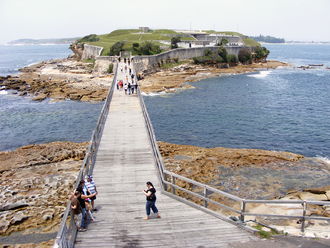Bare Island is connected by a footbridge to the suburb of La Perouse. The historic military fort and tunnels can only be visited by guided tour. The waters around the island are popular with scuba divers.
The island was featured in Mission: Impossible II.
History
Bare Island was part of the traditional land of the Gweagal and Kameygal Aboriginal tribes. In 1770, it was described as ‘a small bare island’ by early explorer, Lieutenant James Cook.
In 1877 it was decided that a fort was to be built on the island. Botany Bay was considered the back door into Sydney, thus making the city vulnerable to a seaborne attack. The construction of a fort on the island would reduced the odds of an attack from this entry point. Plans for the construction of a fort were drawn up by the Colonial Architects Department and tenders in 1880. Government tender for construction was awarded to John McLeod and Co, who also built the Georges Head and Middle Head fortifications. Construction of Bare Island fort was completed in 1885 at a cost of 34,000 pounds. Work inside the fort began in 1889. The Bare Island Fort was designed by Colonel Scratchley, the plans were prepared by Mr Morell, CE and supervised by James Barnet (1827-1904).
In 1890 a Royal Commission found that construction of the fort was faulty due to the use of an inferior grade of concrete. The whole project started to crumble before it was completed. The Royal Commission was very critical of the material used and were reluctant to refer to the material as concrete. The two clerks who were responsible for the operation, Henry Purkis and Edwin Colley, were found to be neglectful in their duties of inspecting the site. The contractor responsible was asked to repay some of the money that was paid out to him. He was also banned from any other government contracts. The Colonial Architect Mr James Barnet who is more widely known for designing many of the beautiful sandstone buildings in Sydney was eventually blamed for failing to oversee the project and to limit the amount of extra funds paid out to the contractor. This led to his resignation in disgrace from government office.
Though bristling with guns, the fort was soon made redundant by advancing technology. By 1902 Bare Island was decommissioned and ceased to exist as a military fortification, with only a handful of military personnel manning the fort. In 1912, Bare Island became a retirement home for war veterans from the Crimea, Sudan and China campaigns. It continued to operate as a retirement home until 1963, after this the Randwick District Historical Society became caretakers of the island. In 1967 it was passed onto the New South Wales Parks and Wildlife Service for use as a museum and tourist attraction. The Bare Island fort has now been declared an historical site.


No comments:
Post a Comment